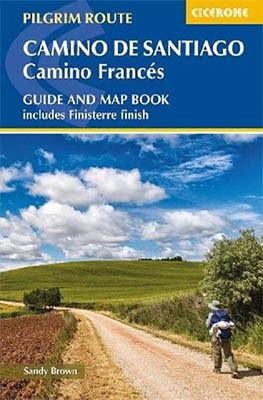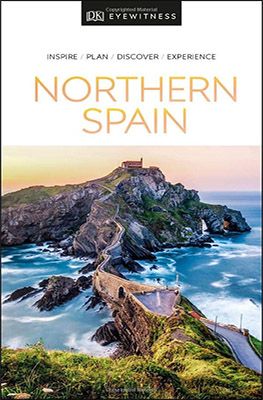For pilgrims, Santiago de Compostela in Galicia is the end of their pilgrimage. Reaching the country’s main pilgrimage site marks the end of the Camino de Santiago. For city tourists, a visit to Santiago de Compostela is the beginning of an introduction to an atmospheric city full of sights. The city’s historic centre is not on UNESCO’s World Heritage List for nothing. As the centre is nice and compact and completely car-free, you can easily get to all the highlights on foot. Before we describe Santiago de Compostela’s sights, we’ll first delve into the history of this place of pilgrimage and its pilgrimages.
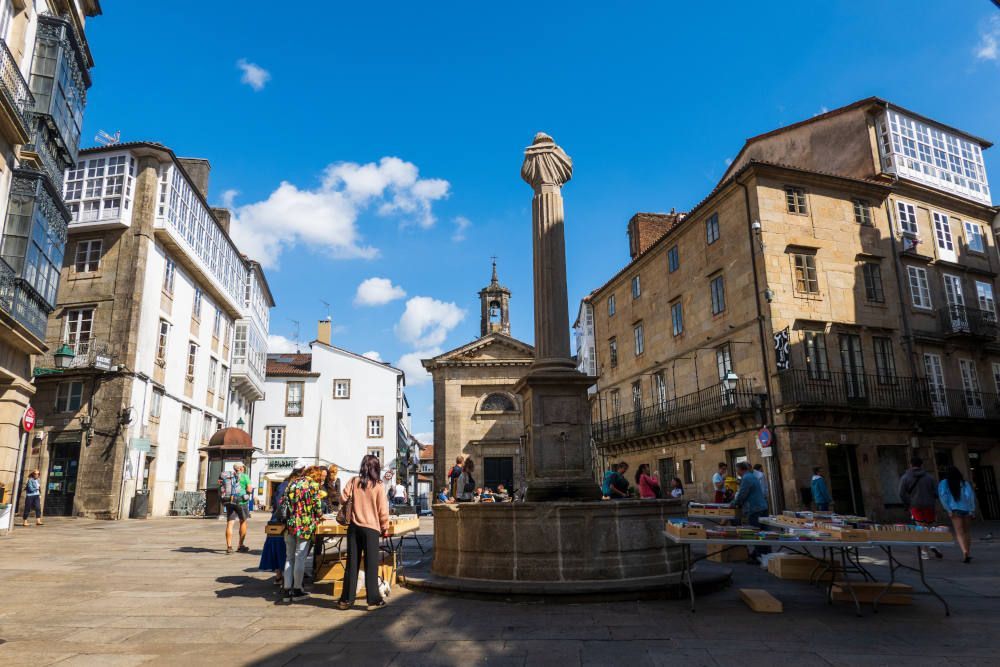
The history of Santiago de Compostela
Its origins are inextricably linked to the legend of the discovery of the remains of James. He was one of the apostles of Jesus. After Jesus’ crucifixion, James went to the northwest of Spain to preach the gospel. When he returned to Jerusalem, James was beheaded. In a boat, they brought his body back to Spain and buried him in the area where he was active as a missionary.
In 813, a shepherd saw a mysterious light in a forest. It led him to an ancient tomb. An alarmed bishop also saw the light and found the tomb. He informed King Alphonsus II that this must be the tomb of Apostle James. To honour the apostle, a church appeared at the site of the find. Soon this became an important place of pilgrimage for believers. Houses were built around the church and so a town came into being. Monasteries, hospitals and inns appeared to accommodate and care for all the pilgrims.
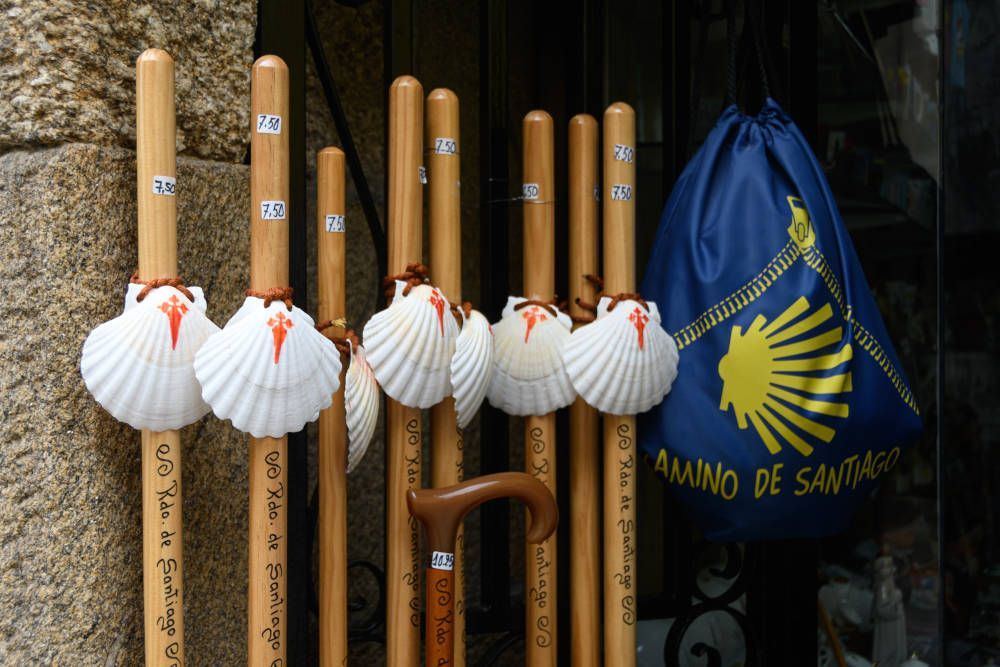
Matamoros
Around that time, Spain was experiencing a major battle with the Moors. A legend surrounding James also circulates about this war. During one of the battles, the king of Asturias is said to have had help from a mysterious knight. This heroic knight killed many Moorish opponents. Thanks to this help, the Spanish won the battle. According to myth, this knight was Apostle James. He owes his title Matamoros (Moro Slayer) to this.
In 997, the Moors destroyed the church and surrounding buildings. Fortunately, they left James’ crypt intact. King Alfonso VI had a new church built on the same spot some 100 years later. It grew into one of the most important pilgrimage sites for Christians. After Jerusalem and Rome, Santiago de Compostela was the place for believers to gather. It brought enormous prosperity to the city.
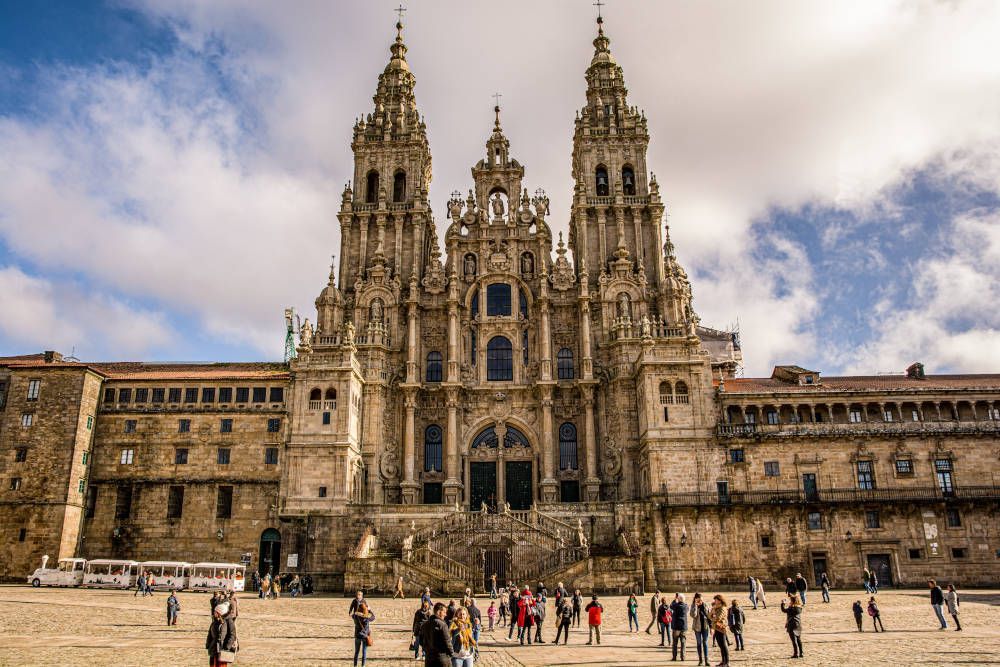
Pilgrimages to Santiago de Compostela
For centuries, pilgrims have travelled to Santiago de Compostela by various routes. Immediately after the completion of the cathedral in the 11th century, travellers from all corners of the world flocked to the city. After the 14th century, there was less interest in the pilgrimage. This was mainly due to the many epidemics and wars that plagued Spain. At the end of the 19th century, pilgrimages increased again.
There are more than 10 Santiago roads leading to Santiago de Compostela. The best known and also the longest is the Camino Francés. It starts at the French border and is about 800 kilometres long. The Camino Francés is also the most popular Jacob’s Way among pilgrims. We wrote two blogs about the highlights on this route:
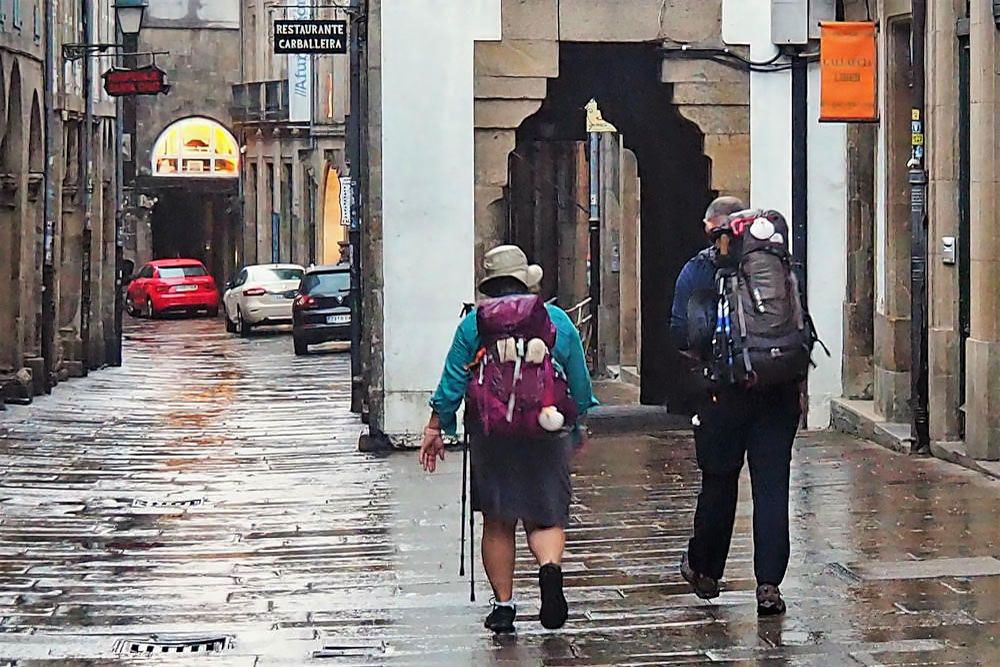
In the main square in front of the cathedral, pilgrims reach “kilometre 0”. For many, this is a poignant moment. At least as impressive is the farewell that pilgrims say to each other. They have met along the way on the route. Sometimes they have spent days or weeks together and have become friends for life.
At the Camino office, they are given the certificate and the scallop shell. They are proof that the Camino has been completed. To obtain this, a pilgrim must have walked a minimum of 100 kilometres. Hence, many walkers start in Sarria. That is just far enough from Santiago to qualify for the certificate and the shell.
Every day at 1 p.m., a special mass is held in the cathedral for all pilgrims. It is a beautiful sight to see the hundreds of runners there wearing their sporting outfits. During our visit, the weather was extremely bad. That made the sight even more special, with all those brightly coloured ponchos and rain suits inside the cathedral.
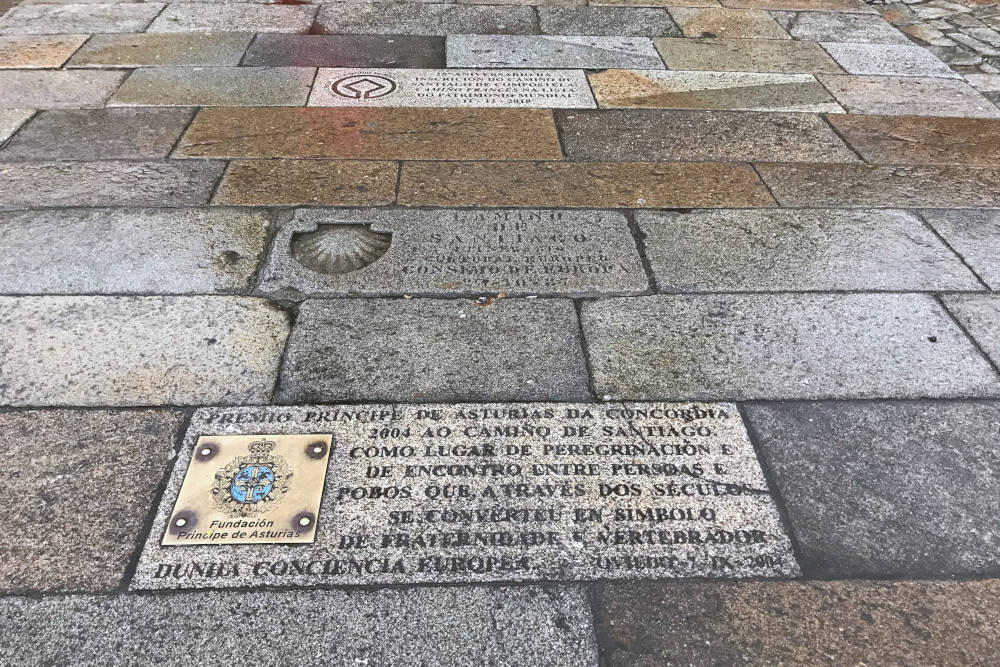
Sights of Santiago de Compostela
These sights of Santiago de Compostela are not to be missed:
Casco Historico, historic centre
Santiago de Compostela’s historic centre is a UNESCO World Heritage Site. It is completely car-free. This makes it ideal for exploring on foot. All the city’s monumental buildings are located in the Casco Historico. You will find several churches, museums, old university buildings and other monuments. In addition, the narrow streets and alleys have plenty of nice shops, restaurants and bars. You will also find numerous souvenir shops with religious mementos.
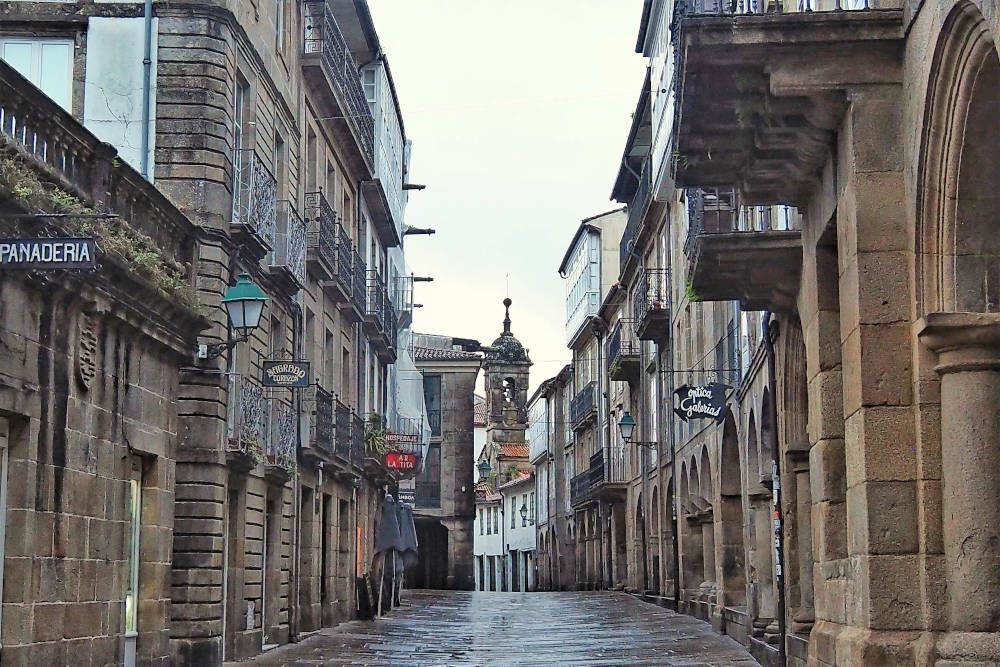
Cathedral of Santiago de Compostela
This is the highlight of the city and not just for pilgrims. The magnificent cathedral dates back to 1078, but it was only consecrated at the beginning of the 13th century. In the centuries that followed, the sanctuary was regularly enlarged. For instance, the façade of the Obradoiro was not installed until the 18th century. This also explains the baroque style of the façade.
The gateway Pórtico da Gloria is only open during holy years. The last sacred year was 2021. They extended that once for a year because of Covid-19. Therefore, we had the privilege of entering the church through this entrance. Around this 12th-century entrance portal are statues of apostles and prophets. Behind the portal is a statue of its creator, Mateo.
Inside, the cathedral is of immense beauty. Under the main altar is the crypt where the remains of St James and two of his disciples lie. Also special is the giant 1.5-metre censer. This “Botafumeiro” weighing more than 50 kg hangs at the top of the cathedral. At important masses, eight monks swing the vessel back and forth.
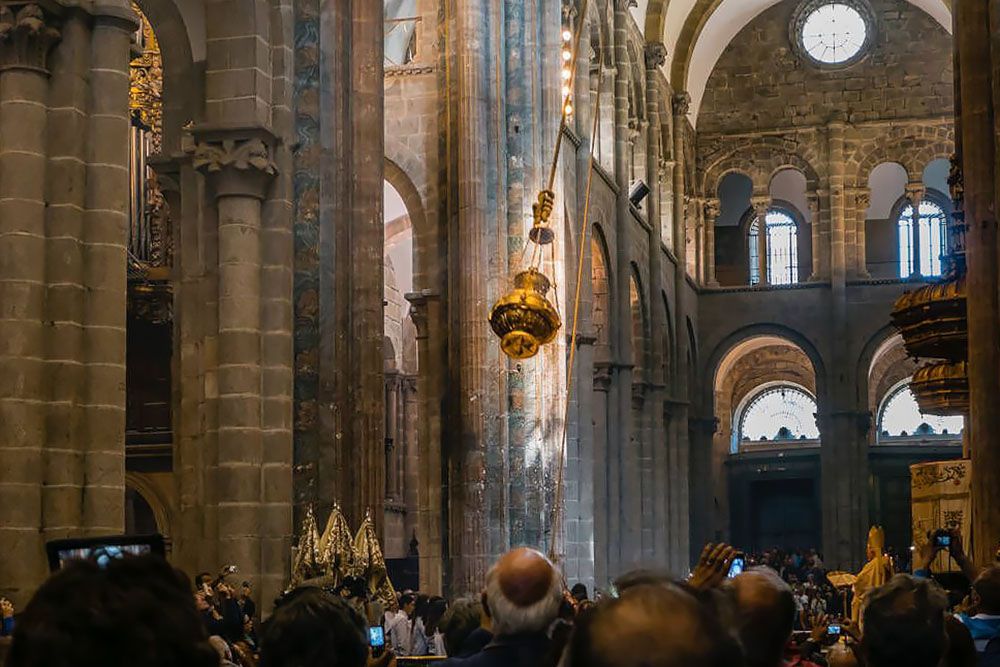
Plaza del Obradoiro
Many call this majestic square the most beautiful square in the world. We dare not say so, but Plaza del Obradoiro is indeed beautiful. The square is the heart of the city, with the cathedral as the main ‘eye-catcher’. This is where pilgrims arrive daily to be photographed at “kilometre 0”. Surrounding the Plaza del Obradoiro are the town hall, a former palace and the former hospital, among others. The best view of the square is from the roof of the cathedral. Hopefully, you’ll have better weather than us. Stormy winds and lots of rain made this a wet, windy and slippery outing.
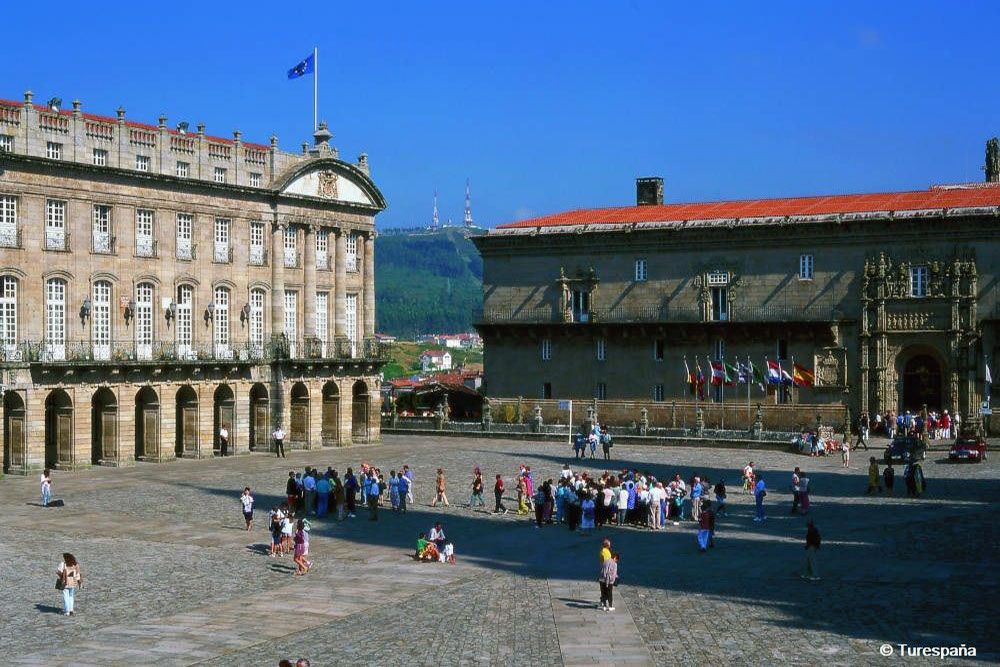
Palacio de Rajoy
Opposite the cathedral is a neoclassical palace from 1766. It served as the residence for Archbishop Rajoy. Of particular note is the large statue on the palace roof showing Apostle James on a horse. The former palace has had numerous functions over time. Now it serves as city hall and office of the president of Galicia’s regional government.
Hostal de los Reyes Católicos
In the Middle Ages, Santiago had several hospitals and inns. They served as shelters for weary and ill pilgrims. At Plaza del Obradoiro, Hostal de los Reyes Católicos was built in 1499. The order to build this inn with hospital was given by King Ferdinand and his wife Isabella.
These days, you can also be looked after in this building. It has now become a beautiful hotel. If you want to stay princely in Santiago, this Parador de Santiago is the location of choice.
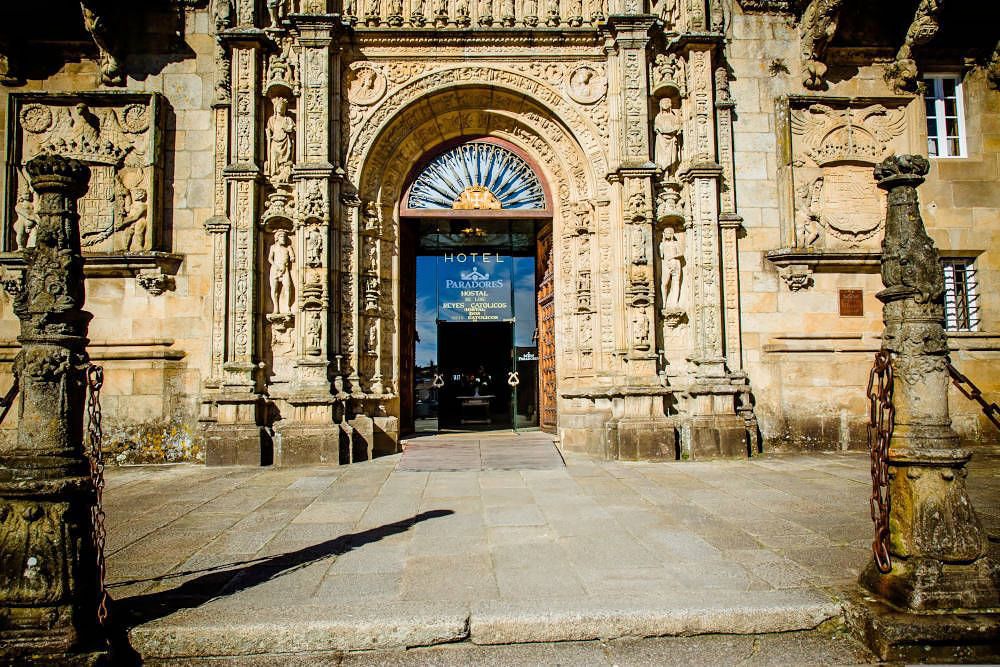
Special monasteries
The Convento de San Paio de Antealtares is one of the city’s oldest monasteries. It was built in the 9th century to care for and worship the newly found tomb of James. This monastery is located on the atmospheric Plaza de Quintana near the bell tower.
At Plaza de la Inmaculada is Monasterio de San Martin Pinario. It is a large Benedictine monastery complex. The monastery originated in the 11th century. It was closed in the 19th century. However, you can still visit it. Notable are the gilded altar and the collection of paintings and religious objects.
Convento de San Francisco was founded by St Francis of Assisi in 1214. In the 18th century, the convent was rebuilt and a Baroque-style church came in front of the building. Yet you can still find several elements from the monastery’s early period. For example, the five Gothic arches at the entrance to the monastery date from the early period.
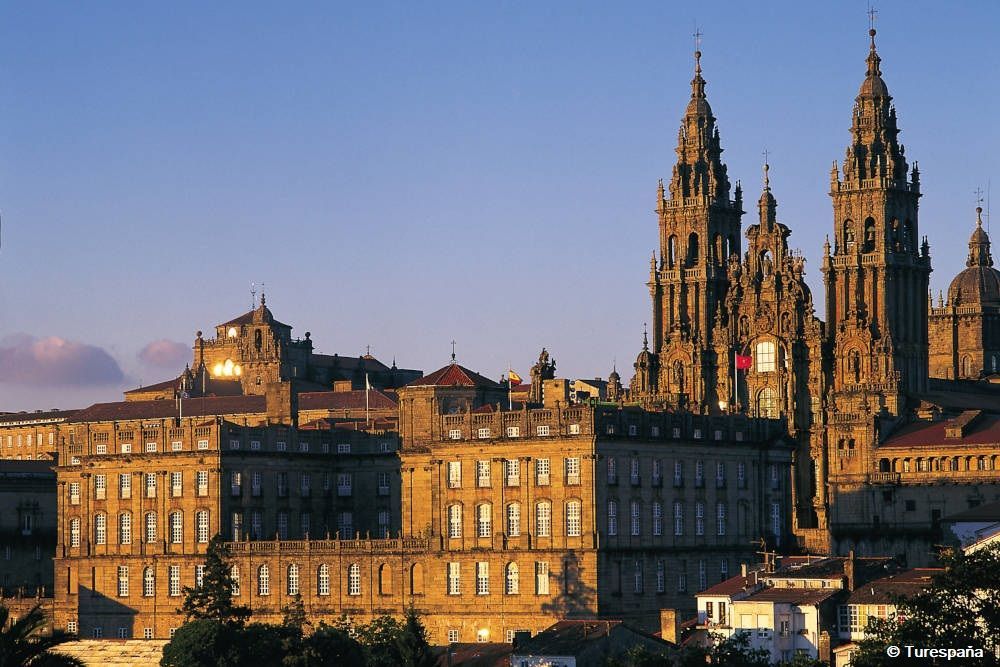
Museums in Santiago de Compostela
With so many pilgrims visiting the city for centuries, it is no surprise that there is also a pilgrim museum. The Museo de las Peregrinaciones shows the history of pilgrimages to the city. It also has several works of art. The 16th-century painting “Santiago Peregrino” is one of the masterpieces.
The CGCA, the Galician Centre of Modern Art, is the region’s most important modern art museum. The museum includes a collection of more than 1,200 artworks by artists from Galicia. You can visit the museum for free. Also be sure to take a look at the museum’s terrace.
Museo do Pobo Galego is an anthropological and folk museum. Here you will learn all about Galician culture, life and traditions. The museum is housed in an old monastery, Monasterio Santo Domingo de Bonaval.
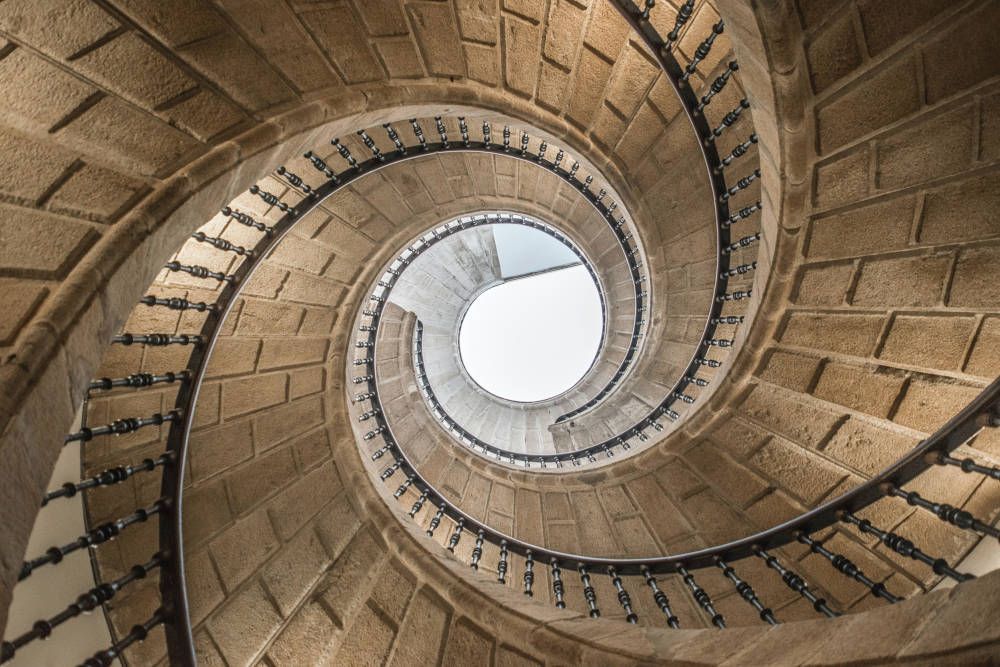
Real Universidad de Santiago de Compostela
For centuries, Santiago de Compostela has been not only a pilgrimage city but also a city of many students. Its university is one of the largest in the country and among the oldest in the world. USC, as the university is popularly known, was founded in 1495 by Archbishop Alonso III de Fonseca. Now, more than 40,000 students study at USC. This makes the students a large part of the city’s total population. All the buildings are scattered around the city. In the historic centre you will find the oldest buildings. Especially beautiful is the library of the faculties of geography and history.
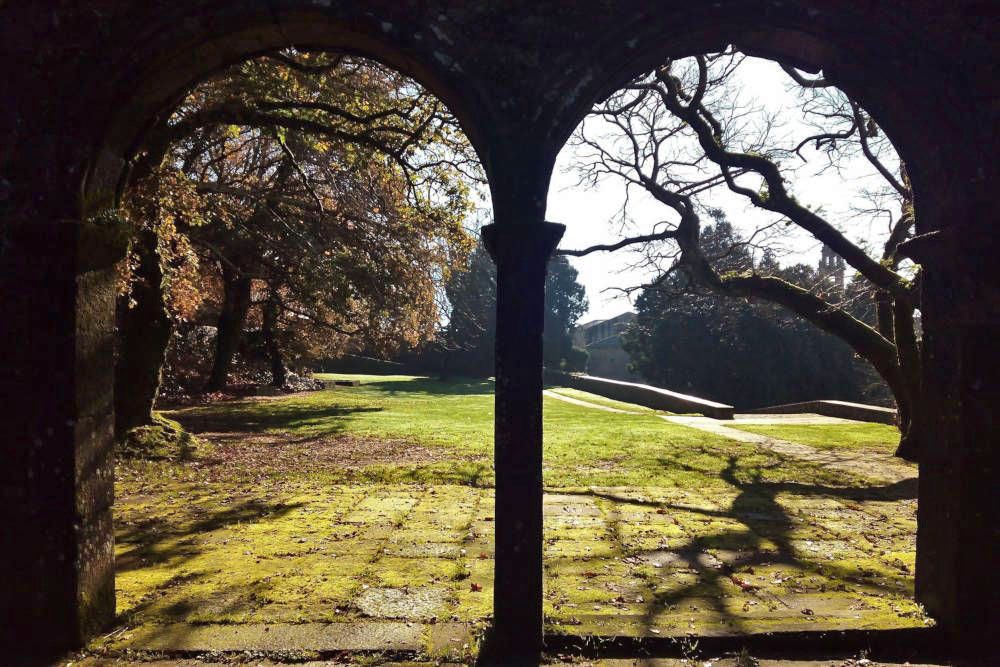
Finding peace and quiet in city parks
If you are looking for peace and quiet after visiting all the highlights of Santiago de Compostela, you can visit two beautiful city parks.
- Parque da Alameda is located between the old town and the new part of the city. It is the city’s largest park. You will enjoy beautiful views of Santiago and, of course, the cathedral. In the shady park you will find a small church, a special chapel and many ponds.
- Another nice park is the San Domingos de Bonaval Park. It is located on the grounds of a former Dominican monastery. A few years ago, an architect and an artist redesigned the park. It really is an oasis of tranquillity, as few people visit this park. You can still see remnants of the monastery walls. You can also visit the monastery garden. From the park, you can walk straight to Museum CGAC and Museum Pobo Galego.
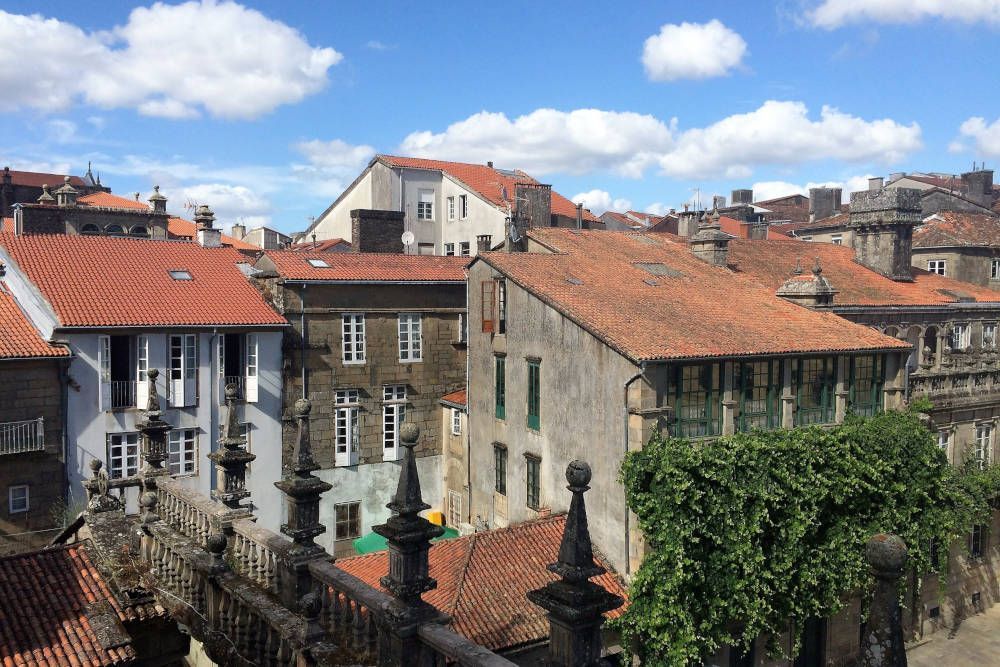
Frequently asked questions about a city break to Santiago de Compostela
Santiago de Compostela is located in north-west Spain. It is the capital of the region of Galicia.
The best time to visit Santiago de Compostela is in the months of April, May, June, September or October. During the summer months, many Spanish tourists come to the city. Especially in a holy year, Santiago is crowded all year round. It is a holy year when the birthday of Saint James falls on a Sunday. The next holy year is in 2027. In any case, the city is very busy every year around the 25th of July because of the many festivities that take place then. If you want to experience that, you should book accommodation in Santiago de Compostela well in advance.
Keep in mind that the city is one of the rainiest in Spain. Its northwestern location near the Atlantic Ocean causes a lot of rain and strong wind. The summer months offer the best chance of sunshine and dry weather.
Santiago de Compostela is a great and fun city. There is a special atmosphere due to the mix of many pilgrims, students and locals. Santiago de Compostela's historic centre is a UNESCO World Heritage Site for a reason. That's where you'll find most of the city's sights. Like the imposing cathedral, the main square Plaza del Obradoiro, several churches and monasteries and cosy squares.
Santiago de Compostela's greatest attraction of all is its imposing cathedral. The entrance gateway Portica de Gloria is unique, as are the high altar and the crypt. The cathedral is located on the Plaza del Obradoiro. Many consider this the most beautiful square in the world. Numerous unusual buildings line the square. Santiago de Compostela's historic city centre is a UNESCO World Heritage Site.
Fish dishes predominate in Galician cuisine. Pulpo is a local speciality. It is boiled octopus cut into pieces and served with paprika. They serve as tapas, but also as a meal with potatoes. You will also come across a lot of scallops on the menu. Other specialities include tetilla cheese, green peppers and tortillas de patatas (omelette with potatoes). As a local dessert, the Tarta de Santiago is a delicacy. It is an almond cake topped with the cross of the Order of St James.
Good restaurants in Santiago de Compostela include:
These lodgings make for a princely stay in the city. Whether you want to rest after walking the Camino, or during your city break to Santiago de Compostela.
This is the complete range of accommodation in Santiago de Compostela.

